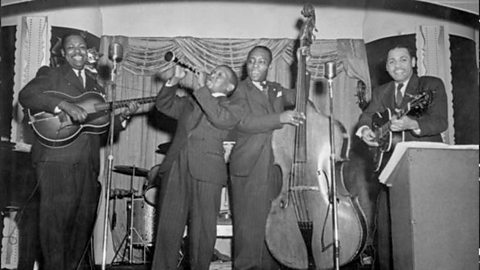Social and cultural developments
The prosperity of the 1920s enabled new forms of cultural expression and entertainment to flourish. People had more disposable incomeMoney available for spending and saving once taxes have been deducted. and more free time to spend their money on entertainment and leisure. There were also changes to the law and social standards.
Cinema
By 1929, Hollywoodās film studios were making more than 500 films each year. Going to the cinema had become a popular activity and ticket sales increased. Actors such as Charlie Chaplin and Clara Bow became popular icons. The first full-length film featuring sequences of spoken dialogue, known as a ātalkieā, was released in 1927.
During the 1920s, movie attendance soared. By the middle of the decade, 50 million people a week went to the movies - the equivalent of half the nationās population.
Jazz

Jazz was largely the creation of black musicians. It began in New Orleans in the American South. Jazz spread to urban cities around the nation as African Americans migrated north. They did this in ever-increasing numbers in what became known as the Great MigrationThe movement of six million African Americans between 1916-1970 out of the rural south into the urban cities of the North and West.
Jazzās rhythmic style and upbeat tempo appealed to young people across society, many of whom enjoyed listening to jazz in bars and nightclubs. New dances such as the Charleston, the tango and the black bottom also added to the excitement of the jazz age.
The position of women in society
Many American women experienced important changes in the 1920s. Women had contributed to the war effort in World War One by taking over jobs traditionally done by men while men were away fighting in the war. After the war, women were also given the right to vote with the passage of the 19th amendmentA change made to the US Constitution after it came into force in 1789.
Flappers
Fashion reflected the new loosening of social standards that some women experienced. In 1919, fashionable womenās skirts were commonly around six inches from the ground, and by 1927 they were at the knee. This was mainly the style of the flapperThe term used to describe a liberated, young, fashionable woman in 1920s America whose behaviour would have been considered unconventional.
- Flappers were women who broke many traditional boundaries of femininity as defined by society.
- They were also heavily influenced by the fashion seen in many Hollywood films at the time.
- Flappers were known for their bobbed, short hair and for wearing lipstick, and also for their enjoyment of dancing, smoking and drinking in jazz clubs.
- They were mainly middle- and upper-class women from cities in the North.
Key changes and continuity in the position of women during the 1920s
| Type of change | Key details | Extent of the changes |
| Political |
|
|
| Social |
|
|
| Economic |
|
|
| Type of change | Political |
|---|---|
| Key details |
|
| Extent of the changes |
|
| Type of change | Social |
|---|---|
| Key details |
|
| Extent of the changes |
|
| Type of change | Economic |
|---|---|
| Key details |
|
| Extent of the changes |
|